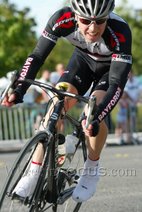Road racing is a tough sport, not just physically but also just getting used to the manner in which races unfold. A road race is unlike other other endurance races where the strongest athlete almost always wins and races play out in a relatively straightforward way. Of course, luck, equipment, and tactics come into play in every endurance sport, but even among the cycling disciplines, road racing rises above the rest in terms of tactical complexity. To say this is not to belittle the other disciplines of cycling or endurance sports in general - it is simply the way road racing is. It is up to you to decide whether or not this tactical component enriches your experience of the sport or dilutes it.
In a road race, the rider who wins is not always the strongest in the race, but is among the strongest who chooses to put in a hard effort at the right time. Quite often, especially in the beginner categories, a strong rider will drive the pace at the front the whole time, only to use up all his energy long before the finish, where he might end up watching as his competitors surge ahead for a better placing. Road racing is all about conserving as much energy as possible until a critical moment arises, and then putting in a maximal effort (intelligently) for the rest of the race. It takes a keen tactical sense to make the right move at the right time, and the best way to develop such a tactical sense is to get out there and race.
A great example of proper race execution comes from Team Cycle University rider Alex Telitsine at Mason Lake #2 a couple of weeks ago. While I was looking over his power meter file from the week before at Mason Lake #1, I noticed that his average power for the race (216 watts) was a little on the high side given that the race came down to a field sprint. Given that his threshold power is around 275 watts, most of his race efforts should be below 200 watts, unless he is in a breakaway or similar situation. An average power over 200 indicated that he was spending too much energy working when he could have been sitting comfortably in the field putting out much less power.
For the next race in the series, Alex decided to spend more time sitting in but at the same time remain vigilant and try some attacks towards the end of the race. Conserve, then attack. He executed this plan perfectly, and broke away with another rider with just over one lap remaining in the race. The breakaway stuck and Alex finished an excellent 2nd place, bringing home the first podium of the season for Team Cycle University. While the average power from the two races was almost identical (213 from ML#1, 216 from ML#2), his effort in ML#2 was divided into two distinct sections: for the first 1:20 he was sitting in the pack and conserving energy, averaging just 187 watts, then for the last 40 minutes he was in the breakaway and put out 274 watts to drive the break, a near-maximal effort for the duration.
So, we can see how conserving for the majority of the race, then making a committed hard effort can lead to a better result than a constant effort throughout a race. Additionally, this is a good example of why it is important to race with your power meter. Without these data, we would have no quantitative idea on what Alex did during the race - how much energy he uses to sit in the pack, how much power he puts into his attacks, and the overall intensity of the entire race.
skip to main |
skip to sidebar
Follow us on Facebook
About Cycle U
Cycle University is an endurance sports coaching company with 2 retail bicycle shops founded by former pro cyclist Craig Undem based in Seattle, WA . Cycle U is run by experienced professional coaches focused on providing athletes, fitness enthusiasts, and hobbyists with the proper education, training and equipment to empower self improvement and personal excellence. Whether the focus is recreational, advanced, or professional level, the education and processes crafted by Cycle University provides the knowledge, practice & expertise to improve your athletic performance.
Services include: athletic coaching, bike fitting, fitness testing, skills clinics, private lessons, indoor InCycle classes, bootcamps, coaching consultations and teams for Triathlon, Cyclocross, Road, Non-Racing Performance and MTB.
Services include: athletic coaching, bike fitting, fitness testing, skills clinics, private lessons, indoor InCycle classes, bootcamps, coaching consultations and teams for Triathlon, Cyclocross, Road, Non-Racing Performance and MTB.
We also have 2 full service shops that sell Specialized and Felt Bicycles along with a full array of gear and clothing.
Going strong since 2004.
Cycle U's Mission Statement
It is our mission to significantly help people become healthier, stronger, safer, and faster, by using science, as well as our experience as coaches, experts and educators to maximize health and performance. We commit to make our community a healthier and better place through endurance sport.



